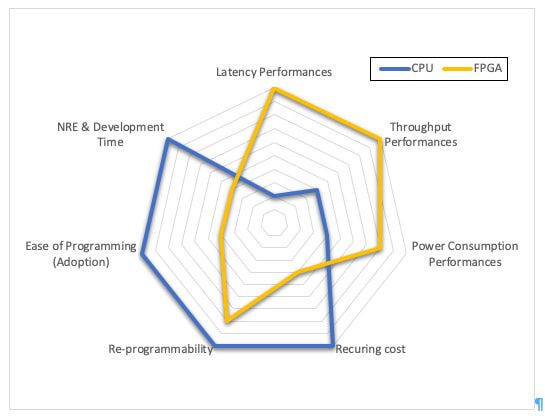
Learn pros and cons of FPGAs, explore the various industries that utilize FPGAs for high-performance applications, and gain insight into when it is appropriate to use FPGAs in conjunction with CPUs.
Wherever you see incredibly fast, leading-edge technology like autonomous driving, electronic trading, and satellite communications, look for FPGAs. The processing capabilities, massive bandwidth, and energy efficiency of FPGAs is allowing designers to create increasingly high-performance solutions for many market segments and industries.
How the FPGA landscape is changing rapidly
How different industries are using FPGAs in high-performance applications
Look at what’s happened in just a few years:
FPGA Market size exceeded USD 6 billion in 2021 and is poised to grow at over 12% CAGR from 2022 to 2028.
The January 2020 article Could FPGAs Outweigh CPUs in Compute Share? from nextplatform.com says, “According to Xilinx CTO, Ivo Bolsens … FPGAs won’t just gain incremental momentum, they will put the CPU out of work almost entirely. ‘In the future you will see more FPGA nodes than CPU nodes. The ratio might be something like one CPU to 16 FPGAs,’ Bolsens predicts, adding that it’s not just a matter of device numbers, ‘acceleration will outweigh general compute in the CPU.”
When an application requires a lot of information to be processed quickly, FPGA solutions offer higher performance compared to standard CPUs. Although the use of standard CPU platforms is still the most flexible option, in some demanding applications the use of FPGA solutions is fully justified.
The main reasons for using FPGAs instead of CPU-based solutions are:
How do FPGAs deliver such high performance? As explained in The Principles of FPGAs on electronic design.com, “Unlike processors, FPGAs are truly parallel. Each independent processing task is assigned to a dedicated section of the chip. Therefore, the performance of one part of the application is not affected when more processing tasks are added.”

Spider chart comparing CPU and FPGA
Despite all the advantages, some factors limit the use of FPGAs on a larger scale:
The High-End FPGA Showdown series (part 3 Design Tools – Where it All Begins) on eejournal.com states, “Engineers with software-only backgrounds often fail to appreciate the complexity involved in using these devices and the long learning curve required to gain enough proficiency to use FPGAs near their capability…Taking full advantage of FPGAs requires digital logic to be designed, and, despite decades of progress, we are not yet at the point where FPGAs can be optimally used without at least some degree of hardware expertise in the FPGA design process.”
To overcome these challenges, the two main FPGA manufacturers, AMD/Xilinx and Intel are trying to democratize access to FPGAs by offering design tools that allow FPGAs to be programmed using more standard programming languages, such as C, C++, and Python, accessible to a larger pool of developers.
And, a growing ecosystem of solutions is available that allows developers to accelerate development times without reinventing the wheel. Some vendors now offer complete framework solutions that integrate multiple FPGA modules (cores) along with software drivers and libraries enabling system developers to focus their development on their applications and differentiators.
FPGAs have been deployed at massive scale in data centers, military and aerospace applications, telecommunication infrastructure, healthcare, and now in ADAS and autonomous vehicles.
Which applications are best suited to use FPGAs? We’ll provide a few examples for each of these key verticals:
The aerospace and defense market is generally less sensitive to cost compared to consumer applications, making FPGAs even more likely to be adopted by manufacturers in this segment.
Examples of Aerospace & Defense FPGA applications:

As we enter the 5G communication era, the next generation of wireless technology will present enormous opportunities for businesses, industries, and consumers.
We’re seeing 5G communication offering multiple capabilities, including
To overcome complex technical issues and continuously evolving standards, AMD/Xilinx’s latest FPGAs (Versal™) have been used by Samsung to build a universal, flexible, and scalable platform that can address multiple operator requirements. In this example, FPGAs are used to provide
In the long run, manufacturers of 5G commercial base stations are likely to eventually replace FPGA devices by converting them into ASIC devices. Such conversions will generally provide power consumption improvement and huge cost reduction savings for commercial base station manufacturers.

Using FPGA for hardware acceleration in data centers has gained a lot of traction recently. Hyperscale customers are increasingly adopting FPGA to cope with increasingly complex workloads across compute, storage and networking applications.
Here are a few emerging applications that take advantage of FPGA in data centers to accelerate their workload:
Achieving maximum throughput and ultra-low latency performance while having the flexibility to reconfigure the hardware is paramount for financial technology and network acceleration applications. Video, imaging, and HPC applications leverage FPGA technologies for their high throughput, power consumption efficiency, and reconfigurability to adapt to evolving workloads.
Discover how FPGAs were used to develop ultra-low latency and ultra-low gate count Ethernet MAC/PCS and RS-FEC IP Cores for latency-critical applications including algorithmic trading in this case study.

Automated driving systems require the highest level of safety to enable the new world of mobility fully. Automotive-grade FPGAs and MPSoCs (FPGAs with Embedded ARM processors) deliver high performance and low latency to allow safety-critical functionality in the new era of Autonomous Driving.
The various vehicle sensors generate massive amounts of data, all of which must be merged into a single data pipe for real-time processing. The data aggregation, pre-processing and distribution capability of FPGAs and MPSoCs helps improve AI processing by merging sensor data and efficiently preparing it for vehicle control.
Thanks to their I/O bandwidth, massive computing capabilities, low-latency performance, and reconfigurability, automotive-grade FPGAs and MPSoCs are ideal for implementing ADAS and AD functionalities.
Key examples of Automotive FPGA and MPSoC solutions:
Artificial intelligence and machine learning technologies are contributing to smarter, more efficient, and effective solutions for the healthcare industry. The quantity of data, calculations, and images that need to be processed quickly makes high-performance FPGA applications ideal for medical solutions.
Examples of Healthcare FPGA solutions:
In this case study, find out more about the breakthrough innovation behind a digital mammography detector that uses an FPGA design for a highly programmable image processing engine.
FPGAs offer additional benefits to medical solutions, such as security and the ability to update functionality. The wired.com article Most Medical Imaging Devices Run Outdated Operating Systems says, “health care providers can make updatability a major priority in procurement to push manufacturers toward more flexible designs.”
To take advantage of the performance of the FPGA and the flexibility of the CPU, some products combine both. An example would be to use an FPGA to continuously process, at full line rate, millions of packets per second by decoding each packet and extracting meaningful information that can be effectively presented to multiple Virtual Machines (VM) running on CPUs. Software solutions can then be deployed on CPUs to enable detailed analysis of the data collected to extract higher-level information that can be presented to the end users.
Discover how a cost-effective FPGA/CPU solution was developed for unique cloud–based digital advertising applications in this case study.




Connect with our team of experts right in your inbox.
© Orthogone - All rights reserved